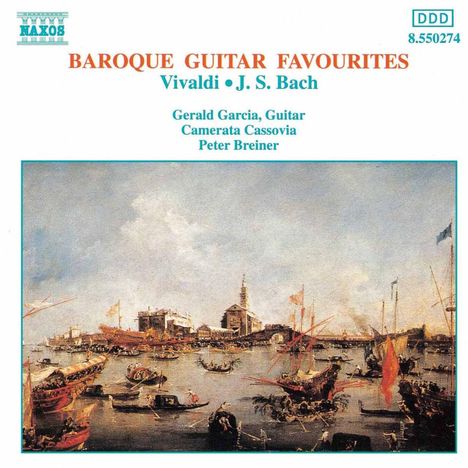Antonio Vivaldi: Gitarrenkonzerte RV 93,277,425,540 auf CD
Gitarrenkonzerte RV 93,277,425,540
Herkömmliche CD, die mit allen CD-Playern und Computerlaufwerken, aber auch mit den meisten SACD- oder Multiplayern abspielbar ist.
(soweit verfügbar beim Lieferanten)
+Bach: Concerto BWV 1052 (arrangiert als Gitarrenkonzert)
- Künstler:
- Gerald Garcia, Camerata Cassovia, Peter Breiner
- Label:
- Naxos
- Aufnahmejahr ca.:
- 1990
- Artikelnummer:
- 6366449
- UPC/EAN:
- 4891030502741
- Erscheinungstermin:
- 31.8.1992
- Serie:
- Naxos Guitar Series
Antonio Vivaldi war einer der besten Geiger seiner Zeit, und viele seiner Konzerte wurden für seine eigene Aufführung geschrieben. Dazu gehören das Konzert in e-moll, Opus 11, Nr. 2, bekannt als II Favorito, und eines, das dem Kaiser Karl VI. gewidmet ist. Es handelt sich um eines der besten Konzerte dieser Zeit in Bezug auf Ausdruckskraft und Organisation des musikalischen Inhalts. Die auf der Gitarre des zwanzigsten Jahrhunderts vorhandenen Möglichkeiten der Subtilität des Ausdrucks und der nachhaltigen Noten ermöglichten es mir, dieses Meisterwerk mit kaum einer Veränderung zu transkribieren. Eine offensichtlichere Wahl für die Transkription ist jedoch die Lautenmusik, die Vivaldi schrieb, da sowohl Gitarre als auch Laute durch Zupfen der Saiten mit den Fingern erklingen. Ein Teil des Charmes des Zupfsaitenklangs liegt darin, dass eine Note, sobald sie gespielt wird, verklingt. Das Konzert in D-Dur rückt die Laute in den Vordergrund, und viele Solopassagen werden nur durch den Basso continuo unterstützt. Diese Lautenstücke wurden um 1730 geschrieben und einem Böhmen, Graf Wrtby, gewidmet. Die Triosonaten in C-Dur und g-Moll, RV 82 und RV 85, wurden ursprünglich für Violine, Laute und Continuo geschrieben, anstelle der üblicheren zwei Violinen. Auch hier ist die Transkription der Lautenpartie für Gitarre relativ einfach.
Product Information
Antonio Vivaldi was one of the best violinists of his day, and many of his concertos were written for his own performance. Among these is the Concerto in E minor, Opus 11, No. 2, known as II Favorito, and one of those dedicated to the Emperor Charles VI. This is one of the finest concertos of the period in terms of expressiveness and organisation of musical content. The possibilities for subtlety of expression and sustained notes available on the twentieth century guitar enabled me to transcribe this masterpiece with hardly any alteration. A more obvious choice for transcription, however, is the lute music which Vivaldi wrote, as both guitar and lute are sounded by plucking strings with fingers. Part of the charm of the plucked string sound lies in the dying away of a note as soon as it is played. The concerto in D major brings the lute to the fore and many solo passages are supported by only the basso continuo. These lute pieces were written around 1730 and dedicated to a Bohemian, Count Wrtby. The Trio Sonatas in C major and G minor, RV 82 and RV 85, were originally written for violin, lute and continuo, instead of the more usual two violins. Again, transcription of the lute part for guitar is relatively straightforward.
Rezensionen
"Sensible Phrasierung, starke Tonqualität und ordentliche Verzierungen sind immer vorhanden" (Classical Guitar)Disk 1 von 1 (CD)
Konzert für Violine, Streicher und Basso continuo e-moll op. 11 Nr. 2 RV 277 "Il favorito"
-
1 1. Allegro
-
2 2. Andante
-
3 3. Allegro
Triosonate für Violine, Laute und Basso continuo C-Dur RV 82
-
4 1. Allegro non molto
-
5 2. Larghetto - Lento
-
6 3. Allegro
Trio für Violine, Laute und Basso continuo g-moll RV 85
-
7 1. Andante molto
-
8 2. Larghetto
-
9 3. Allegro
Konzert für Laute, 2 Violinen und Basso continuo D-Dur RV 93
-
10 1. Allegro giusto
-
11 2. Largo
-
12 3. Allegro
Konzert Für Cembalo, Streicher Und Basso Continuo Nr. 1 D-Moll Bwv 1052 (Bearb. Für Gitarre)
-
13 1. Allegro
-
14 2. Adagio
-
15 3. Allegro
Mehr von Antonio Vivaldi
-
Antonio VivaldiConcerti op.8 Nr.1-4 "Die vier Jahreszeiten" (Dresdner Fassung mit Bläsern)Super Audio CDAktueller Preis: EUR 7,99
-
Antonio VivaldiViolinkonzerte "per Anna Maria" RV229,248,343,349,366,387Super Audio CDAktueller Preis: EUR 7,99
-
Antonio VivaldiTito Manlio RV 7383 CDsAktueller Preis: EUR 9,99
-
Antonio VivaldiConcerti op.8 Nr.1-4 "4 Jahreszeiten" (für Panflöte & Orchester)CDVorheriger Preis EUR 17,99, reduziert um 0%Aktueller Preis: EUR 7,99








